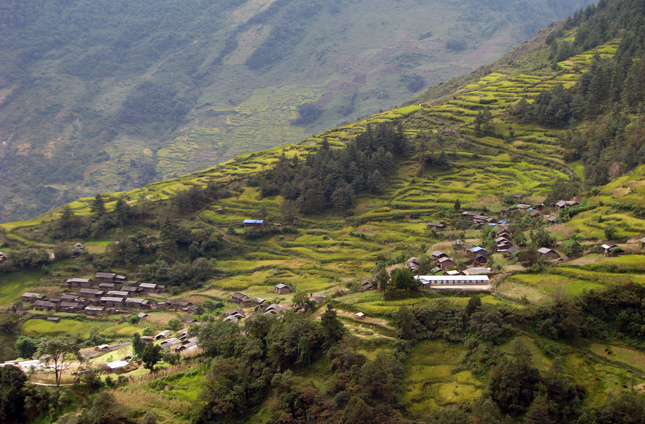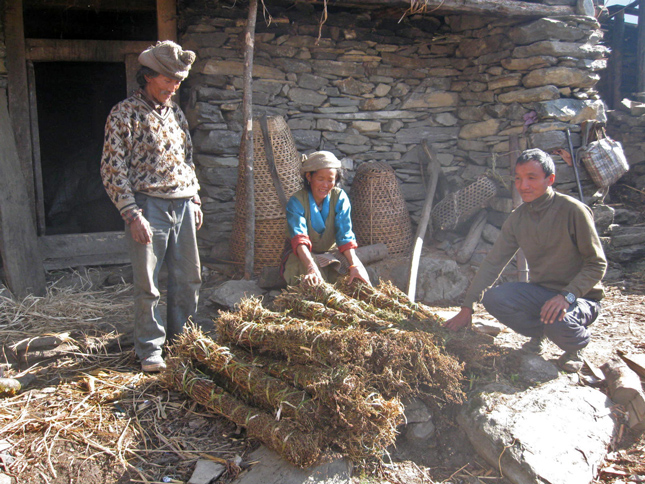-
High Poverty: Medicinal Plants Offer Way Forward for Nepal’s Mountain Communities

In a tiny village called Chepuwa in the Sankhuwasabha district of Nepal, high in the Himalayas and almost four days’ trek from the nearest road, Mikmar Bhote has been growing and selling medicinal and aromatic plants for five years.

Chepuwa Village, Sankuwasabha, Nepal (Karma Bhutia) In a tiny village called Chepuwa in the Sankhuwasabha district of Nepal, high in the Himalayas and almost four days’ trek from the nearest road, Mikmar Bhote has been growing and selling medicinal and aromatic plants for five years.
A farmer and mother of four, the income she’s earned has allowed her to send her daughters to school and buy a new metal roof for their home. The switch from a traditional wood roof to metal has reduced pressure on nearby bamboo stocks, critical food for endangered species. And the agricultural techniques she uses are helping shore up a fragile, largely deforested local environment while providing critical ingredients for many medicines.
300 million people living in mountain areas are vulnerable to food insecurity
Interest in medicinal plants is nothing new. Hauled to India and other parts of Nepal for use in Ayurvedic medicine, and to China for traditional healing, these plants have been traded for centuries. Chiraito (or Chiretta), for instance, has antibiotic properties and is used to treat over two dozen diseases, disorders, and ailments.
The plants are also now used in many Western medicines, like Taxol, used to treat breast, ovarian, lung, prostate, esophageal, and other cancers.
What’s different is that Bhote has joined with her neighbors to cultivate these plants rather than forage for them, a practice that’s devastating for fragile alpine habitats, particularly when combined with yak herding.
The income, environmental, and social changes Bhote and her neighbors have achieved is an example of what The Mountain Institute (TMI) is working to replicate across the Himalayan region of Nepal.
Fragmented Families
Globally, about 300 million people living in mountain areas are vulnerable to food insecurity. Many of them are desperately poor, with conditions generally worse at higher altitude. As the twelfth poorest country in the world, Nepal has an overall poverty rate of 25 percent (GNI $730), but the rate in the high mountain regions averages 46 percent.
There are few good livelihood opportunities for mountain communities. Everyone knows about trekking to Mount Everest; however, earnings for indigenous communities in Nepal tend to be very localized with the bulk of the profits often going to outside companies. The unprecedented early closing of the mountain last spring was in part the result of mounting tensions between locals and foreigners over these inequities.

Mikmar Bhote and her husband selling Chiraito to a local buyer (Karma Bhutia) Mining and other natural resource extraction processes can provide good income, but all too often are poorly managed. When not undertaken in a responsible and sustainable manner, they can tear mountains apart and result in little benefit for the villagers who then have to live with the consequences.
Without a way to get ahead, or even feed their families, Nepalese parents – generally fathers – take jobs elsewhere, principally in India and the Gulf States. Official remittance flows to Nepal (about $5 billion annually) reached 25 percent of GDP in 2012, making it the third largest recipient in the world.
News accounts have documented bad conditions for migrant workers, but the untold story is of fragmented families. Men and boys are sometimes stranded abroad, while women, children, and the elderly are left at home to cope as best they can. In 2013, 42 percent of the farmers that TMI worked with were women.
A Better Option
Growing medicinal and aromatic plants can provide an excellent alternative for some mountain regions. Such high value products make economic sense, even if they have to be carried to market on the backs of yaks, mules, horses, or humans. Moreover, these can be produced year after year.
Some 16,000 highland farmers in six districts are cultivating 12 species on over 2,000 hectares
Since 2001, TMI has partnered with local civil society to train farmers to cultivate medicinal and aromatic plants on their own plots as well as on degraded land. TMI has also helped establish cooperatives to further fair trade and improve marketing. Farmers have adapted fast, learning to cultivate on the edges of steep mountain terraces and inter-crop so they can grow medicinal plants side-by-side with other cash and food crops.
The results have been impressive. To date, some 16,000 highland farmers in six districts are cultivating 12 species on over 2,000 hectares. In 2013, the families TMI worked with earned more than $800,000 combined. Most impressively, two farmers made over $30,000 – a huge sum in impoverished Nepal – and are well on their way to being middle class.
We estimate that these 16,000 farmers are currently providing about 10 percent of Nepali production of medicinal plants. The goal now is to turn others away from wild collecting.
We also hope that such earnings will bring some migrant workers home, and dissuade others from leaving in the first place, reducing the familial fracturing so common in Nepalese households today.
Benefits Flow Downhill
The environmental benefits of cultivation are also considerable – and more than a local concern. In the steep terrain of the Himalayan highlands, healthy forests are essential to limiting erosion. Standing plants and trees capture and store water, helping to sustain freshwater flow during the dry season while reducing flood risks when it does rain.
Downstream, millions of people in the northern Indian plains, one of the largest and most populous areas of irrigated agriculture in the world, depend in large part on water from Bhote’s highlands. When the Himalayas do not supply adequate water – or too much – many suffer.
With reduced foraging and yak grazing, Nepal’s alpine areas can start to recover. Agroforestry work related to the project has contributed to restoring tree cover to over 550 hectares of degraded land. Wild harvesting has put Himalayan yew on the endangered list, but the farmers we work with have now planted some 225,000 seedlings, which in time will reduce pressure on wild stocks.
An Integrated Approach
We believe the best way to reduce poverty and encourage gender equity in mountain regions is through a sustainable development approach that integrates livelihoods with environmental and cultural concerns. Done right, mountain lives are improved, communities remain vibrant, and people downhill and downstream gain too.
The best way to reduce poverty and encourage gender equity is through a sustainable development approach
Demand for medicinal plants from the Indian and Chinese markets far exceeds current supply and includes more than 100 species. Mountain Institute staff see a clear path to scaling up to 50,000 farmers in Nepal alone, and what we have learned could be deployed in other remote mountain regions. Indeed, we have started similar work in the Peruvian Andes.
Some of the challenges ahead include improving trade policies and implementing international organic or fair trade certification (we have already helped implement a certification scheme for in-country trade in Nepal).
Mountain people can be remarkably resilient and adaptable – given tough environments and frequent broader societal neglect they have to be – and we have seen they can haul themselves out of poverty with just a little help.
Andrew Taber is the executive director of The Mountain Institute where he oversees programs to improve community livelihoods, protect local cultures, and conserve biodiversity and ecosystems services in fragile mountain regions around the world. Meeta Pradhan directs TMI’s Himalayan Program and specializes in issues of gender, particularly in the context of the extreme climate change pressures mountain communities are facing today.
Sources: Circle of Blue, The Guardian, Karobar National Economic Daily, The Mountain Institute, The Wall Street Journal, World Bank.
Photo Credit: Chepuwa Village and Mikmar Bhote and her husband, used with permission courtesy of Karma Bhutia/The Mountain Institute.
Topics: agriculture, Asia, China, community-based, development, economics, environment, featured, flooding, food security, forests, gender, Guest Contributor, India, land, migration, natural resources, Nepal, poverty, water
 A Publication of the Stimson Center.
A Publication of the Stimson Center.




